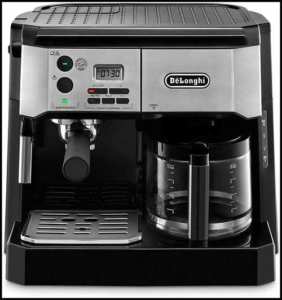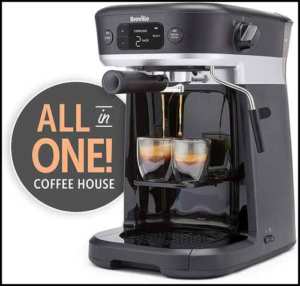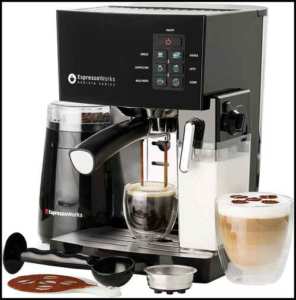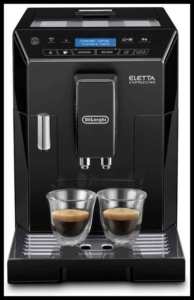Which is the Best Coffee Maker with Espresso Option?
Note: This page contains affiliate links.
As an Amazon Associate, I earn from qualifying purchases when you click on the link, but you are not charged extra.
Why Would You Need A Coffee Maker With Espresso Option?
With the proliferation of ostentatious, spendy drinks from high-street coffee shops, it is easy to forget that some of the best coffee (in my experience, at least) can be made at home with a coffee maker. Given the complexity of the drinks you can buy at your local coffee shop, it is even easier to forget why you need a coffee maker with espresso option.
The fact is, an espresso shot (or two) is the basis for most famous Italian-style coffee drinks, from americanoes to mochas: it’s important to assess your machine on its espresso-making qualities as this is the building block of all your more complex drinks; it’s important to get the hang of the best coffee makers with espresso options on the market.
And what’s more, it allows you to change your coffee habits up. Although there are sometimes features that allow drinks like lattes to be made wholly by the machine, it doesn’t allow you much freedom to change your drink up at all, to experiment with new flavours and combinations. Having a coffee maker with an espresso function will allow you the liberty to do exactly this. An espresso-making facility would also allow you to incorporate your favourite coffee into hard drinks, like an expresso martini.
How To Choose The Best Coffee Makers With Espresso Options
I found it quite tricky to get to grips with all of the different functions that modern coffee makers have within them: it is not difficult to get confused by all of the jargon, especially when a first-time buyer. However, there are some key categories and features that you’ll need to get your head around, and assess their relative importance to you:
Wattage
The higher the wattage, the quicker that the water will be heated up by the machine. If you’re planning on making lots of espressos at once, this might be of more importance to you.
Thermblocks
A thermoblock is essentially a metal block with a heating element and a water pipe inside it. As water travels along it, it will heat up. Because they only heat up water prior to its immediate use, they are more energy efficient, and generally what you will find in smaller coffee making machines. However, the system can sometimes produce inconsistent results with regard to temperature: the more traditional boiler system will probably give you more consistent cups of coffee (given that temperature, in coffee brewing, is quite intimately related to taste), but they’re more difficult to clean and are generally more pricy.
Valves
The more high-end coffee makers will probably boast a solenoid valve: this will mean that they’ll be increased water pressure, and will shut off as soon as you finish the extraction. On other models, however, you’ll have to do this manually: the valve will be mechanical, manual. I don’t think there’s that much difference between the two, but it’s something to consider.
Bar Pressure
Look out for a bar rated between 15 and 19. It’s essential for steam to meet coffee granules at the correct speed: if it’s too slow your espresso can turn out quite bitter.
Milk frothers
Despite the importance of a good espresso function, if you’re looking for a coffee machine that makes milky drinks, you should consider the benefits of an automatic frother. This feature will take care of milk frothing — an important part of the process in making a cappuccino or similar — inside the machine. Manual frothers, on the other hand, have a tube coming out of your machine for you to do this part of the process yourself.
Pod or bean-to-cup?
The coffee makers at the cheaper end of the spectrum by and large use capsules: you’ll be tied into buying a specific type of capsule (e.g. Nescafe) each time you run out. This will limit you in terms of blends (especially decaf blends), but you’ll also enjoy pretty consistent results due to the uniformity of each capsule and its contents. You should also be aware that the capsules create quite a bit of waste: it’s not a particuarly environmentally-friendly way to make your coffee if you drink it regularly.
On the other hand, there’s bean-to-cup coffee makers. These models — usually more expensive — they have an internal grinder, and make you a drink from the coffee beans you’ve inserted. Usually, this will involve you grinding up some coffee beans, though some accept grounds, too. There’s loads of boutique and specialist coffee beans on the market, all with their own specialities and extensive tasting notes, as well as more bog-standard ones, so you have a lot of options open to you. However, you are not necessarily guaranteed a better coffee from these sorts of machines: sometimes they produce really mediocre coffee compared to the pod counterparts.
Related: Coffee Maker with K Cup and Carafe
Best Coffee Machine With Espresso Options
De’Longhi BCO430BM Coffee Maker With Espresso Option with Advanced Cappuccino System

De’Longhi BCO430BM Coffee Maker With Espresso Option with Advanced Cappuccino System
This coffee and espresso combo is optimised for convenience: both water and coffee reservoir alike are positioned at the front of the machine, meaning that there’s no need to keep moving the maker around the place when refilling. And for good reason: weighing over 10 pounds, it’s a pretty weighty bit of equipment. But at the same time, it’s a stylish, professional looking piece of kit, so it can definitely remain in pride of place on your kitchen work top. The cappuccino function produces particularly smooth results, and the in-machine carbon water filter means that you’ll get a better tasting cup of coffee due to the removal of impurities. This is a good option for a fairly serious coffee drinker and maker: it’s financially and spatially quite a commitment to take on, but will definitely yield you some great results.
Breville All-in-One Coffee House

This machine offers a huge amount of freedom in your coffee habits: it makes cafe-style espresso coffees and filter coffees alike, from both pods and coffee grounds. The type of pod that the machine will accept is Nescafe Dulce Gusto, which obviously ties you down to a certain brand (as all pod-type machines will), but luckily there’s a wide range of blends within this brand, and they are fairly easy to get hold of. And anyway, if you do end up running out of pods, you’ll still be able to make some filter coffee for yourself: you won’t have to resort to a make-shift pourer method or buying your drinks out. The shelf on which the cups stand is collapsable, which means that you can have your coffee in a travel mug, so you’ll probably end up saving money when on the go. As well as a fifteen bar pressure pump, there’s the other features you’d expect from a good coffee machine; a fully integrated steam wand and a fairly capacious water tank. But what really sets this machine apart is its flexibility: it produces coffee drinks for all sorts different occasions.
EspressoWorks 10Pc All-in-One Barista Bundle Espresso Machine & Cappuccino Maker

Boasting a nineteen-bar pressure for espresso making, this machine is able to make single or double shot drinks as well as cappuccinos and lattes. It has a coffee grinder, meaning that you change up your blends as you go, and aren’t tied down to a particular brand or blend of coffee. The machine comes with an array of useful accessories: two cappuccino and two espresso cups, a spoon and sixteen coffee stencils. This means that the machine is a good option for novices: it’s easy to use as well as composed of powerful and premiums components. It does. however, have a lower wattage rating than some of the other models discussed, meaning that you’ll have to wait a little longer for the water to heat up and the extraction processes to start, but really, unless this is particularly important to you, it’s not a particularly noticeable or overriding difference.
De’Longhi Eletta, Fully Automatic Bean to Cup Coffee Machine

De’Longhi are a brand that are dominating this selection, but for good reason: they are produce consistently good coffee machines for those who are willing to spend a little more on their kit. This machine would make a good addition to a family home, or a house in multiple occupation: it has a massive two litre water tank, and can produce two cups of coffee simultaneously. You can easily customise the milk level according to your taste, and even use the machine to make a simple cup of tea, too. It takes beans or pre-ground coffee, so there’s lot of room for different tastes. And what’s more, it boasts a memory function, so your favourite drink and style can be made at the touch of a button. This machine is a great investment for anyone who is going to want a premium and consistent results several times a day, potentially for multiple people: under these conditions, it’s likely worth the price.
Tips and troubleshooting questions
Even once you’ve chosen your coffee maker, it is sometimes difficult to get to grips with your new purchase, especially as a newbie. With this in mind, we’ve put together a few tips and answers to frequently answered questions to help you on your way:
What milks can I use when frothing?
A real twenty-first century question, this one! All milks apart from rice milk with froth up, so if you have any allergies or dietary requirements, you’ll still be able to enjoy the frothy milk element of so many of the popular coffees.
When should I clean my coffee machine?
The simple answer is: it depends. Some models — particularly those with thermoblock technology — have reduced chances of scaling, whereas others do not. Of course, the chance of scale also depends on your water supply, too. It would obviously be ideal to clean your maker after every use, but I know the chances of anyone actually doing this are incredibly slim. Overall, you should probably clean it every other month at the least, and wipe it down along with all your other daily kitchen cleaning chores. Vinegar is a good way to get rid of limescale, but make sure you wash the system out thoroughly afterwards, of course.
How can I make sure that my coffee is fresh?
For those who have opted for a bean to cup model, you’ll have to make sure you’re using fresh beans, if you’re committed to making the best cup of coffee possible. Luckily, there’s an easy test. A little known property of coffee beans is their elasticity, their bounciness: a fresh bean will bounce if thrown on the floor. Try it with one bean and see what happens.
Why is the coffee coming out so slowly?
There are a few reasons why this might be happening, with some easy fixes. It could be because your machine requires cleaning and descaling. It could also be because there’s too much coffee in the filter, so try adjusting this. If neither of these things help, it’s worth consulting the machine-specific manual, or phone up the manufacturer.
What is a steam wand?
Most of the more complex machines will have one of these. It’s basically a feature that allows you to froth up your milk: pour your milk of choice into a small jug and engage the steam wand, putting the spout just below the surface of the milk. Move the wand up and down until the milk is sufficiently uniformly frothy: it should have the appearance of melted ice cream. It’s now ready to be used in whatever milky drink of your choice.
Which is the Best Coffee Maker With Espresso Option?
So there we have it: some tips and recommendations for your consideration. There is no substitute for actually seeing these items in the flesh, and the only way you’ll truly get to know your machine is through use and of course referring back to the manual if any problems arise. With that said, I really think that a coffee maker with espresso option is a great investment if you enjoy even the occasional cup of coffee.
Bestvaluehunt.com is a participant in the Amazon Services LLC Associates Program, an affiliate advertising program designed to provide a means for sites to earn advertising fees by advertising and linking to Amazon.com.